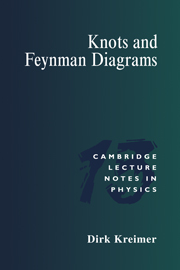Book contents
- Frontmatter
- Contents
- Acknowledgements
- 1 Introduction
- 2 Perturbative quantum field theory
- 3 The Hopf algebra structure of renormalization
- 4 Rationality: no knots, no transcendentals
- 5 The simplest link diagrams
- 6 Necessary topics from knot theory
- 7 Knots to numbers: (2, 2n – 3) torus knots and ζ(2n – 3)
- 8 One-loop words
- 9 Euler–Zagier sums
- 10 Knots and transcendentals
- 11 The four-term relation
- 12 Hopf algebras, non-commutative geometry, and what else?
- References
- Index
10 - Knots and transcendentals
Published online by Cambridge University Press: 04 August 2010
- Frontmatter
- Contents
- Acknowledgements
- 1 Introduction
- 2 Perturbative quantum field theory
- 3 The Hopf algebra structure of renormalization
- 4 Rationality: no knots, no transcendentals
- 5 The simplest link diagrams
- 6 Necessary topics from knot theory
- 7 Knots to numbers: (2, 2n – 3) torus knots and ζ(2n – 3)
- 8 One-loop words
- 9 Euler–Zagier sums
- 10 Knots and transcendentals
- 11 The four-term relation
- 12 Hopf algebras, non-commutative geometry, and what else?
- References
- Index
Summary
In this chapter we describe results which were obtained recently [Kreimer 1995, Broadhurst and Kreimer 1995, Broadhurst et al. 1996a, Broadhurst et al. 1996b]. In these publications a fascinating connection between field theory, number theory, and knot theory emerges. The starting point of this connection is the results described in Chapters 4 and 5, connecting topologically simple graphs with the absence of knots in their link diagrams, and with the corresponding absence of transcendentals in their counterterms, and the results reported in Chapters 7 and 8, connecting ζ(2l – 3) to (2, 2l – 3) torus knots.
Those previous chapters suggest that the transcendental coefficients in the expansion of regularized counterterms are related to the topology of the diagram. This relation should be via knot theory, which began to emerge in Chapters 7 and 8. As we will see, field theory initiated the invention of a knot-to-number dictionary, which in turn spurred new findings in number theory and opened a new route for calculations in field theory.
We will comment in detail on the four publications mentioned above, following the lines of [Kreimer 1997a]. Each of them gives new insights and support to the connection between renormalization, knot theory and number theory.
- Type
- Chapter
- Information
- Knots and Feynman Diagrams , pp. 174 - 213Publisher: Cambridge University PressPrint publication year: 2000



